Workspace Configuration Settings
You can set a variety of general parameters from the Workspace folder
in the navigation pane. The parameters are available from a right-click
menu, organized under the following categories:
These settings are saved in the appropriate configuration files.
Tip: If you prefer, you can edit these parameters directly
in the associated configuration files. To do so, select Workspace from
the menu bar. In the navigation pane, expand the Configuration
Files folder, and choose the option that opens the file
you wish to edit in a text editor. For details, see Editing Configuration Files.
xE-mail SMTP Server Settings
You can specify an IP address for the email server and
a sender address. If the server is secured, you can specify the
credentials for connecting to the server. You can also test your
email connection from the E-mail Settings pane.
x
Reference: E-mail SMTP Server Settings
To
access these settings, select Workspace from
the menu bar. Click the E-mail SMTP Server icon
on the ribbon, or right-click the Workspace folder
in the navigation pane, and select E-mail SMTP Server.
The E-Mail SMTP Server page opens, as
shown in the following image.
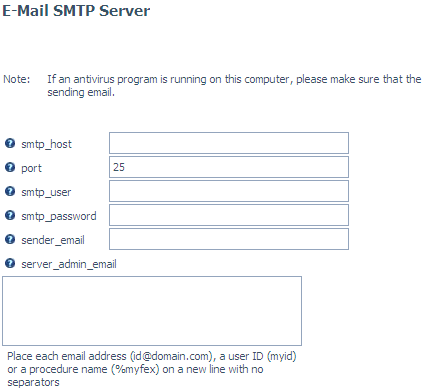
The
following settings are saved in the odin.cfg file:
- smtp_host
-
Indicates the IP address of the SMTP email server using the
notation that is supported for your IP version (for example, for
IPv4, use base 256 standard dot notation. When IPv6 is supported
on a platform, and enabled, you can use either 256 standard dot
notation or IPv6 notation.)
- port
-
Indicates the TCP port number that a client is connecting
to. The default value is 25.
- smtp_user
-
Is the user ID to authorize access to the SMTP server.
- smtp_password
-
Is the password for the smtp_user.
- sender_email
-
Is the sender email address (the address that appears in
the From field in emails).
- server_admin_email
-
Is a list that can consist of email addresses, user IDs and
procedure names (for example, %myfex.fex), each on a separate line,
with no delimiters.
Note: If email
send operations fail, verify that the smtp host is active and/or that
a virus scanner is not blocking edachkup.
When
you have completed your entries, optionally click the Send
Test E-mail button to test your connection, then click Save.
x
Event Routing allows you to launch procedures or send
email based on different server events (agent or listener crashes,
server configuration errors, disk space limitations, and others).
All events are classified by type as information, warning, or error. These
can be pre-defined or custom-defined events.
The Customize Event Routing page shows the Default and Customized
Event Routing.
The Default routings are shown in the following image.
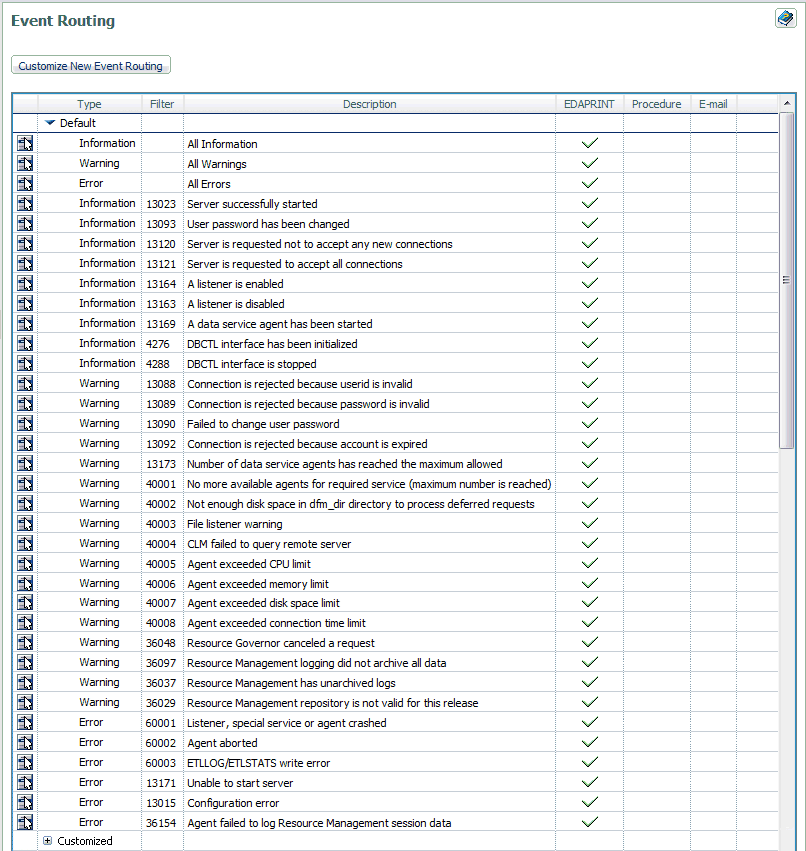
Customized routings are shown in the following image.
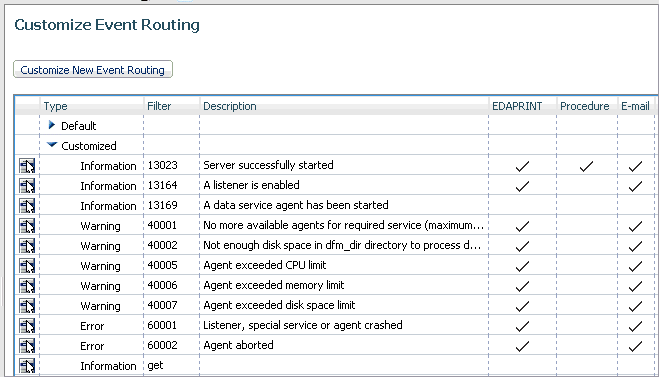
x
Procedure: How to Customize an Event Routing
By
customizing event routing, you can launch a procedure or send email
based on server events.
-
From the
menu bar, select Workspace.
-
From the
ribbon, click the Event Routing icon, or
right-click the Workspace folder in the navigation
pane, and select Event Routing.
The Customize Event Routing page opens.
-
Click Customize
New Event Routing.
The Customize New Event Routing page opens.
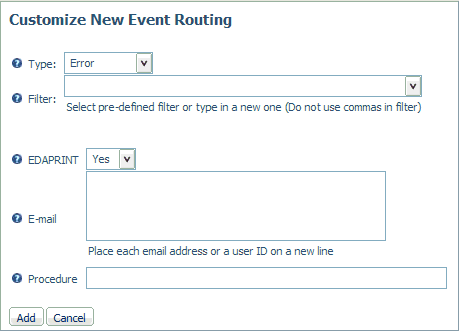
-
From the
Type drop-down menu, select a message type. The choices are Error, Information, Warning,
and Any.
-
Enter a
criteria in the Filter field or select a predefined one from the drop-down
menu.
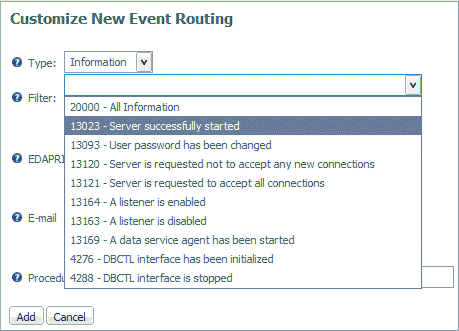
-
From the
EDAPRINT drop-down menu, select Yes if you
want to write the selected event message to the server log.
In z/OS, the selected server messages can be also written
to the z/OS system log by selecting Yes from
the JESLOG drop-down menu, as shown in the following image.
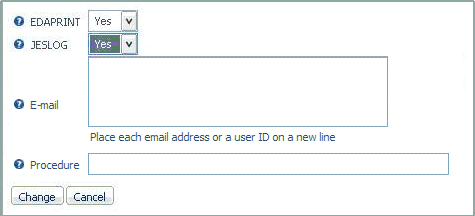
-
Optionally,
enter an email address to send an email when the event occurs.
-
Optionally,
enter a procedure to execute in the Procedure field, including the
application name, for example, utility/movefiles.
-
Click Add.
The event is added to the Customize Event Routing Page.
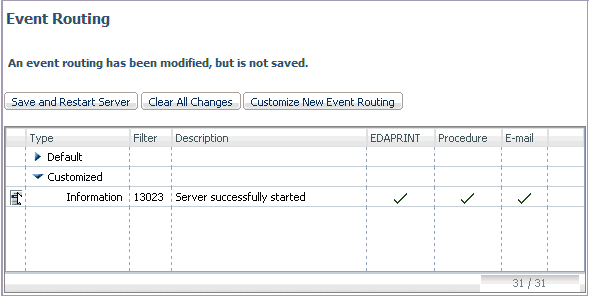
-
Click Save
and Restart Server.
x
Setting Workspace Log Properties for Event Routing
Workspace Log properties allow you to specify a suppression interval
for email notifications from event routing, and to include a number
of lines from the edaprint log file in the email body. The edaprint
log file provides information about the events occurring on the
server before a triggered event.
x
Procedure: How to Set Workspace Log Properties for Event Routing
The
Workspace Log Properties page controls both event routing email
and the edaprint log. For information on the edaprint log, see How to Set Workspace Log Properties to Control the Edaprint Log.
-
From the
menu bar, select Workspace.
-
Open the Logs
and Traces folder.
-
Right-click Workspace
Logs and select Properties.
The Workspace Logs Properties page opens, as shown in the
following image.
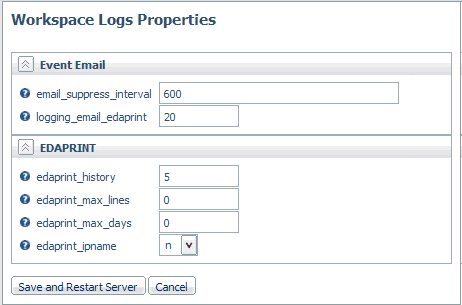
-
Enter or
select values for the Event Email parameters.
The Event Email parameters are:
- email_suppress_interval
-
Suppresses duplicate email notifications if the same event
occurs again during this time interval (in seconds). Zero disabled
suppression. The default value is 1800 (30 minutes).
- logging_email_edaprint
-
Defines the maximum number of server messages from edaprint.log
are included in the email. The default value is 20.
-
Click Save
and Restart Server.
x
When a procedure is triggered by an event, the ID of
the routing event and the text of the event message are automatically
available to the procedure as the EVENT_ID and EVENT_TEXT parameters,
respectively. The EVENT_TEXT parameter needs to be decrypted using
the following user subroutine:
B64DECODE('XXXXXXXXXX', 'Ann');
xNational Language Support Settings
In this section: How to: Reference: |
The Web Console provides the parameters that are required
for configuring the Server for National Language Support (NLS).
x
Times New Roman Font Support for Arabic PDF and PostScript Formats
Users that want to output Arabic characters in PDF or
PostScript formats can now select the Times New Roman font.
x
Tahoma Font Support for Thai PDF and PostScript Formats
Users that want to output Thai characters in PDF or
PostScript formats can now select the Tahoma font.
x
To
access these settings, select Workspace from
the menu bar. From the ribbon, click the NLS icon,
or right-click the Workspace folder in the
navigation pane, and select NLS.
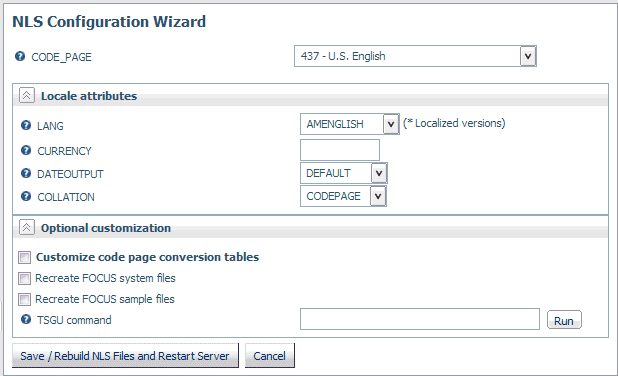
The following NLS settings are saved
in the nlscfg.err file:
- CODE_PAGE
-
Is the code page of the data sources accessed by the server.
Select
a code page from the drop-down list of supported code pages, including Unicode.
The
default value is 1252 for Windows and UNIX, and 37 for IBM i
(formerly known as i5/OS) and z/OS.
The
current value of CODE_PAGE is available to applications as the &FOCCODEPAGE
variable.
Locale attributes
- LANG
-
Controls the default value of the code page, and the language
of server error messages if available in translation.
Choose
a language name or abbreviation from the drop-down list.
The
default value is AMENGLISH (American English) on all platforms.
An
asterisk to the right of a language, for example, French*, means
that the server is localized for that language. Translated server
error messages (for example, FOCnnn through FOCnnnnn)
are available and the Web Console is fully displayed in that language
once you configure and restart the server. For related information,
see How to Add a Dynamic Language Switch to the Web Console Menu Bar.
If you choose a language without
an asterisk, the server messages and console appear in English.
If you would like the messages and console to appear in a language for
which the server has not been localized, you can provide translation
yourself. To localize the console, translate the file wceng.lng
and rename it to wcXXX.lng where 'XXX' is the three-letter language
code for the server. For error messages, translate all or any relevant
*.err files and append the same three-letter language code to it.
All files are located in the \home\nls folder. For related information,
see How to Create a Localized Version of the Web Console Manually.
The current value of LANG
is available to applications as the &FOCLANGCODE variable. However,
it will be blank if it is not configured.
- CURRENCY
-
Enter a one-byte character or hexadecimal value that identifies
a currency symbol.
Examples of one-byte characters are:
- € for euro
- ¥ for yen
- $ for U.S. dollar
- £ for British pound sterling
You can use any other
single character to designate the currency symbol.
Examples
of a hexadecimal value on code page 137 are:
- 0x80 for euro
- 0x24 for dollar sign
- DATEOUTPUT
-
Selecting Localized from the drop-down
menu will provide dates in a localized format.
- COLLATION
-
Establishes a binary or case-insensitive collation sequence.
The values are:
-
CODEPAGE. Bases the collation
sequence on the code page in effect.
-
BINARY. Bases the collation sequence on binary values.
-
SRV_CS. Bases the collation sequence on the LANGUAGE
setting, and is case-sensitive.
-
SRV_CI. Bases collation sequence on the LANGUAGE setting,
and is case-insensitive.
When code page files are not
modified, CODEPAGE is the same as BINARY, except for Danish, Finnish,
German, Norwegian, or Swedish in EBCDIC environment.
The SET
COLLATION command has the same effect, and overrides this default setting
in NLS configuration.
Optional customization
- Customize code page conversion tables
-
Select this check box to display a list of code pages and
descriptions for the possible data sources accessed by the server
or the client code page.
Several code pages are always selected
by default and cannot be deselected. These are:
37 --IBM
MF United States
137 --U.S. English/Western Europe (Latin
1)
437 --U.S. English
1047 --IBM MF Open Systems (Latin
1)
1252 --Windows Latin; 65001 --Unicode (UTF-8)
65001
Unicode (UTF-8)
65002 Unicode (UTF-EBCDIC)
Other code
pages may also be selected by default, depending on the LANG attribute
chosen.
The NLS Configuration Wizard creates conversion tables
for these code pages to make them available for subsequent conversion.
Select
any additional code pages for which you want tables to be created.
For example, if you want to designate a particular code page to
be generated in synonyms for flat (fixed) files or VSAM files, you
must already have created a code page conversion table using the Customize
code page conversion table option during NLS configuration.
- Recreate FOCUS system files
-
Check this box if you wish to load FOCUS internal files in
the server code page (as defined in the CODE_PAGE field).
This
is recommended if the compatibility of the new and prior code pages
is unknown.
- Recreate FOCUS sample files
-
Check this box if you wish to load the sample files (which
are delivered with your software) in the server code page (as defined
in the CODE_PAGE field).
- TSGU command
-
TSGU is a utility program to configure NLS settings. It is
usually not required, but in the following cases it must be executed
manually.
-
To create PDFXTBL. When TYPE 1 fonts should be included
in PDF format file, the TYPE 1 font transcoding table must be generated
using the following syntax:
PDFX {font-name}
-
To create PDFYTBL. When
Unicode fonts should be used in PDF format file, the special font
information tables (PDFYTBL) must be generated using the following
syntax:
KTBL {pdfy-name}
Complete the configuration, then click Save/Rebuild
NLS Files and Restart Server. The server creates the
necessary transcoding, sorting, and monocasing tables for the selected
code page.
x
Procedure: How to Add a Dynamic Language Switch to the Web Console Menu Bar
When you configure the server for NLS:
-
Choose a
language with an asterisk (*) from the LANG drop-down list. The
asterisk indicates that the localized version of the Web Console
is available for that language.
-
Click Save/Rebuild
NLS Files and Restart Server.
-
When the
server restarts, the Web Console is displayed in the selected language.
If you selected a Western European language when configuring
the code page, the associated group of Western European languages,
as well as English, are available on a menu to the left of the Help
option.
-
To toggle
among these languages, simply select the one you want from this
menu.
In
this example, Spanish has been chosen from the menu so the Web Console,
as well as any translated error messages, are displayed in the selected
language.

x
Procedure: How to Create a Localized Version of the Web Console Manually
Follow
this procedure to localize a language that does not have an asterisk
next to its name in the LANG drop-down list. This will enable users
to see both the Web Console and the Data Management Console in the
localized language.
When adding a localized language, the
following files must be created for each language. These files are
located in the EDAHOME NLS directory (for example, c:\ibi\srv77\home\nls).
Each file contains the list of strings
that are used in specific product areas.
|
Area
|
String
|
|---|
|
Web Console
|
wc***.lng
|
|
Synonym Editor
|
nt***.lng
|
|
Data Management Console
|
wc***.lng and dm***.lng
|
where:
- ***
-
Represents the 3-letter language abbreviation code for the
new language you will be translating.
To
localize the files listed in the chart, complete the following steps:
-
Identify
the abbreviation code of the new language. To obtain a list of available
codes, run the ? LANG SET command as a procedure.
The column LANGAB (Language Abbreviation) shows the 3-letter (***) codes.
-
Copy the
three component files that have the English strings and rename them
using the new language code. (The English versions of the files
use the eng language abbreviation code.)
-
Translate
the files with the new language abbreviation codes. To do so, open
each component file in a Text Editor and proceed with the translation
using the following guidelines:
- Translate the strings
on the right side of the equal sign (=). (The left side of the equal
sign (=) contains the string numbers. Do not change these values.)
- Some strings contain
multiple variables (placeholders), such as %s/%s. Be especially
careful to place these strings in context within your translation.
For
example, in the string:
4040 = Create Synonym for %s %s
%s
%s represents the table name for which you are creating a synonym.
In some languages, the table name may be identified in the beginning
or the middle of the sentence, therefore the variable must be placed accordingly.
-
Save the
translated file in EDAHOME NLS directory (for example, c:\ibi\srv77\home\nls)
using an encoding system that is compatible with the default code
page of the language. To check the default code page, run the ?
LANG SET command as a procedure. The column CODEPG (Code Page) shows
the code page.
Once the new language files exist, you can add the localized
language to the Dynamic Language Switch menu by including the ADDLANG
parameter in the nlscfg.err file.
-
To edit
the nlscfg.err file, select Workspace from
the menu bar. In the navigation pane, open the Configuration Files and Miscellaneous folders.
-
Right-click NLS - nlscfg.err,
and select Edit.
The nlscfg.err file opens in the text editor. Add the following
line of code
ADDLANG=language_name
where:
- language_name
Is the language abbreviation code (LANGAB) or language name (LANGNM)
from the ? LANG SET table.
-
To test
the new language, configure the WebFOCUS Reporting Server for NLS
and select the language you just translated as the LANG=value.
-
Save and
restart the Server. When the Server restarts, the localized language
option will be available on the Dynamic Language Switch pull-down
menu.
-
Choose the
desired language and verify that all menus and options are translated
and functioning.
Note: For
your convenience, two reference charts that contain the output generated
by the ? LANG SET command are included in this document. For details, see Language and Default Code Pages for Windows and UNIX or Language and Default Code Pages for IBM i and z/OS.
Example: Localizing the Web Console Into Finnish
For
this example, assume that the server is running on Windows and the
NLS setting is CODE_PAGE=137 and LANG=AMENGLISH).
Follow
these steps:
- The wceng.lng file
contains the original English strings for the Web Console. Copy
and rename the file wcfin.lng.
- Translate wcfin.lng
into Finnish and save it as Latin1(ISO8859-1) in the EDAHOME NLS
directory (for example, c:\ibi\srv77\home\nls).
- From the menu bar
select Workspace. In the navigation pane,
open the Configuration Files and Miscellaneous folders.
- Right-click NLS - nlscfg.err, and select Edit.
The
nlscfg.err file opens in the text editor. Add the following line
of code:
ADDLANG=FINNISH
- Click the Save
and Restart button for the changes to take effect.
- To apply the Finnish
translation, choose FINNISH from the dynamic
language switch drop-down list on the Web Console menu bar.
x
Reference: Language and Default Code Pages for Windows and UNIX
This chart provides information generated
by the ? LANG SET command from the Windows and UNIX platforms.
|
Language Code
|
Language Name
|
Language Abbreviation
|
Language ID
|
Code Page
|
|---|
|
001
|
AMENGLISH
|
AME
|
en
|
1252
|
|
001
|
ENGLISH
|
ENG
|
en
|
1252
|
|
020
|
ARABIC
|
ARB
|
ar
|
1256
|
|
10351
|
B-PORTUGUESE
|
BRA
|
br
|
137
|
|
385
|
CROATIAN
|
HRV
|
hr
|
1250
|
|
420
|
CZECH
|
CZE
|
cs
|
1250
|
|
045
|
DANISH
|
DAN
|
da
|
137
|
|
031
|
DUTCH
|
DUT
|
nl
|
137
|
|
372
|
ESTONIAN
|
EST
|
et
|
923
|
|
358
|
FINNISH
|
FIN
|
fi
|
137
|
|
033
|
FRENCH
|
FRE
|
fr
|
137
|
|
033
|
FRENCH
|
FRE
|
fc
|
137
|
|
049
|
GERMAN
|
GER
|
de
|
137
|
|
049
|
GERMAN
|
GER
|
at
|
137
|
|
030
|
GREEK
|
GRE
|
el
|
1253
|
|
972
|
HEBREW
|
HEB
|
iw
|
916
|
|
036
|
HUNGARIAN
|
HUN
|
hu
|
1250
|
|
039
|
ITALIAN
|
ITA
|
it
|
137
|
|
081
|
JAPANESE
|
JPN
|
ja
|
942
|
|
081
|
JAPANESE-EUC
|
JPE
|
je
|
10942
|
|
082
|
KOREAN
|
KOR
|
ko
|
949
|
|
371
|
LATVIAN
|
LVA
|
lv
|
1257
|
|
370
|
LITHUANIAN
|
LTU
|
lt
|
1257
|
|
047
|
NORWEGIAN
|
NOR
|
no
|
137
|
|
048
|
POLISH
|
POL
|
pl
|
1250
|
|
351
|
PORTUGUESE
|
POR
|
pt
|
137
|
|
040
|
ROMANIAN
|
ROM
|
ro
|
1250
|
|
007
|
RUSSIAN
|
RUS
|
ru
|
1251
|
|
085
|
S-CHINESE
|
PRC
|
zh
|
946
|
|
421
|
SLOVAK
|
SVK
|
sk
|
1250
|
|
034
|
SPANISH
|
SPA
|
es
|
137
|
|
046
|
SWEDISH
|
SWE
|
sv
|
137
|
|
086
|
T-CHINESE
|
ROC
|
tw
|
10948
|
|
066
|
THAI
|
THA
|
th
|
874
|
|
090
|
TURKISH
|
TUR
|
tr
|
920
|
|
044
|
UKENGLISH
|
UKE
|
uk
|
137
|
|
800
|
UNICODE
|
UCS
|
uc
|
65001
|
x
Reference: Language and Default Code Pages for IBM i and z/OS
This chart provides information generated
by the ? LANG SET command from the IBM i and z/OS platforms.
|
Language Code
|
Language Name
|
Language Abbreviation
|
Language ID
|
Code Page
|
|---|
|
001
|
AMENGLISH
|
AME
|
en
|
37
|
|
001
|
ENGLISH
|
ENG
|
en
|
37
|
|
020
|
ARABIC
|
ARB
|
ar
|
420
|
|
10351
|
B-PORTUGUESE
|
BRA
|
br
|
37
|
|
420
|
CZECH
|
CZE
|
cz
|
870
|
|
045
|
DANISH
|
DAN
|
da
|
277
|
|
031
|
DUTCH
|
DUT
|
nl
|
37
|
|
372
|
ESTONIAN
|
EST
|
et
|
1112
|
|
358
|
FINNISH
|
FIN
|
fi
|
278
|
|
033
|
FRENCH
|
FRE
|
fr
|
297
|
|
033
|
FRENCH
|
FRE
|
fc
|
297
|
|
049
|
GERMAN
|
GER
|
de
|
273
|
|
049
|
GERMAN-500
|
GE5
|
at
|
500
|
|
030
|
GREEK
|
GRE
|
el
|
875
|
|
972
|
HEBREW
|
HEB
|
iw
|
424
|
|
036
|
HUNGARIAN
|
HUN
|
hu
|
870
|
|
039
|
ITALIAN
|
ITA
|
it
|
280
|
|
081
|
JAPANESE
|
JPN
|
ja
|
939
|
|
10081
|
JAPANESE-930
|
JPK
|
jk
|
930
|
|
082
|
KOREAN
|
KOR
|
ko
|
933
|
|
371
|
LATVIAN
|
LVA
|
lv
|
1112
|
|
370
|
LITHUANIAN
|
LTU
|
lt
|
1112
|
|
047
|
NORWEGIAN
|
NOR
|
no
|
277
|
|
048
|
POLISH
|
POL
|
pl
|
870
|
|
351
|
PORTUGUESE
|
POR
|
pt
|
37
|
|
040
|
ROMANIAN
|
ROM
|
ro
|
870
|
|
007
|
RUSSIAN
|
RUS
|
ru
|
1025
|
|
085
|
S-CHINESE
|
PRC
|
zh
|
935
|
|
042
|
SLOVAK
|
SVK
|
sk
|
870
|
|
034
|
SPANISH
|
SPA
|
es
|
284
|
|
046
|
SWEDISH
|
SWE
|
sv
|
278
|
|
086
|
T-CHINESE
|
ROC
|
tw
|
937
|
|
066
|
THAI
|
THA
|
th
|
838
|
|
090
|
TURKISH
|
TUR
|
tr
|
1026
|
|
044
|
UKENGLISH
|
UKE
|
uk
|
285
|
|
800
|
UNICODE
|
UCS
|
uc
|
65002
|
x
Server administrators can customize the login and connection
result screens with custom messages. The Login Message option
is available by right-clicking the Workspace folder
in the navigation pane.
x
Procedure: How to Customize the Login Screen With a Message
To
customize the login screen:
-
Select Workspace from the
menu bar.
-
From the ribbon, select the Login Message icon,
or right-click the Workspace folder in the
navigation pane, and select Login Message.
The Login Message page opens.
-
Enter the text of the message in the HTML Message field
in the Before section, as shown in the following image.
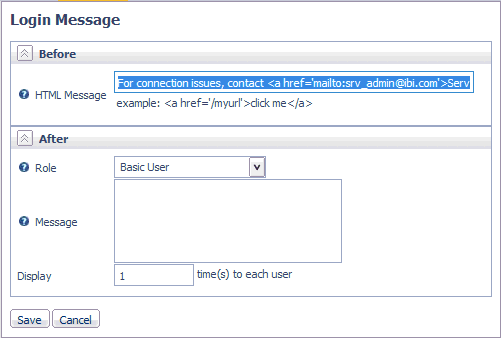
-
Click Save.
The
message is added to the login page, as shown in the following image.
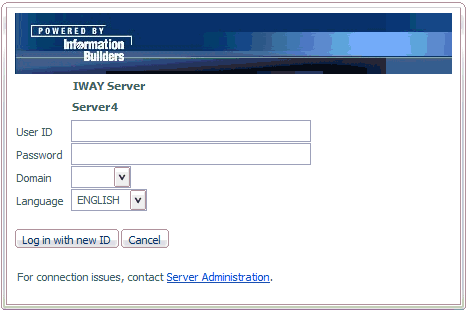
x
Procedure: How to Customize the Connection Result Screen With a Message
Server
administrators can customize the connection result screen for each
user type.
-
Select Workspace from the
menu bar.
-
From the ribbon, select the Login Message icon,
or right-click the Workspace folder in the
navigation pane, and select Login Message.
The Login Message page opens.
-
Select a user type from the Role drop-down menu. The
options are Server Administrator, Application Administrator, Server
Operator, Basic User, and All
Users.
-
Enter the text of the message in the Message field of
the After field, as shown in the following image.
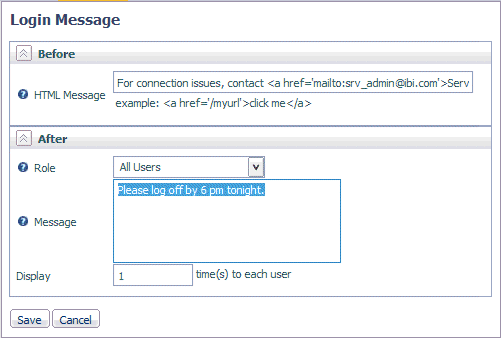
Optionally, you can
set the number of times the message will appear by entering a value
in the Display field.
-
Click Save.
The
message is displayed after a successful connection, as shown in
the following image.

x
The Web Console appearance parameters control the look
of the Web Console, as well as accessibility and menu bar customization.
x
Reference: Web Console Appearance
To
access these settings, select Workspace from
the menu bar. From the ribbon, click the Web Console
Appearance icon, or right-click the Workspace folder
in the navigation pane, and select Web Console Appearance.
The
Web Console Appearance page opens, as shown in the following image.

The
following Web Console Appearance settings are saved in the edaserv.cfg
file.
Server-Wide Default Appearance
- Appearance
-
Controls the look of the Web Console.
Possible values
are RIA-CarbonRounded, RIA-Default,
and RIA-OceanRounded. The default value is RIA-Default.
- WebFocus 80 compatibility
-
Matches the console appearance to WebFOCUS 80. The default
value is No.
Accessibility
- Display Accessibility Option
-
Allows users to enable or disable an accessibility display.
Menu Bar Appearance
- Caption Of The Custom Link
-
Specifies the text of a custom link that is shown in the
menu bar of the Web Console.
- URL Of The Custom Link
-
Specifies the URL of a custom link that is shown in the menu
bar of the Web Console.
- Banner
-
Specifies if a banner image should be displayed on top of
the menu bar in the Web Console. The image file must be located
in EDAHOME/etc/wc directory.
- Menu or Ribbon
-
Specifies whether the Web Console will display a menu bar
or a ribbon. The default is Ribbon.
When you have completed your entries,
click Save.
x
You can control aspects of profile execution from the
Profile Settings pane.
x
Reference: Profile Settings
To
access these settings, select Workspace from
the menu bar. From the ribbon, click the Settings icon,
and select Profile Settings, or right-click
the Workspace folder in the navigation pane,
and select Settings, and then Profile Settings.
The
Profile Settings pane opens, as shown in the following image.
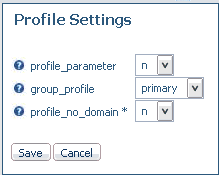
The following Profile Settings are saved
in the edaserv.cfg file:
- profile_parameter
-
By passing parameters to profiles, you can submit different
session parameters at different connection times. When this parameter
is activated, any unresolved variables are prompted for during your
initial logon to the Web Console.
Available settings are y and n.
If
the server, user, or group profiles contain any unresolved variables,
set the profile parameter keyword to y. The
default setting is n.
- group_profile
-
To control the execution of group profiles during logon,
choose:
-
all. All group
profiles for the connecting user are executed in alphabetic order.
-
select. If
the user exists in more than one group, the Web Console prompts
for a group and executes the associated profile.
-
primary. Only
the primary group profile for the connecting user is executed. (This
is the default setting.)
- profile_no_domain *
-
In the Windows Server, to control whether the domain name
is included in or excluded from a user profile name, choose:
n to
add the domain name to the profile name (for example, user ibi/edaport
becomes ibi_edaport.prf). N is the default value.
y to
omit the domain name from the profile name (for example, user ibi/edaport
becomes edaport.prf). This setting is required for compatibility
with earlier releases of the Server.
Note: The y setting
can be safely employed if a single domain is in use and there are
no local user IDs that could interfere with domain IDs. If there
is potential for interference between local user IDs and domain
IDs that are connected to the server, the n setting
is required to ensure that each user has a unique profile name.
Note
that server must be restarted when this parameter is changed.
When you have completed your entries,
click Save.
x
Core engine settings allow you to control a wide range
of services, including Bulk Load, FOCUTL, HLI, Stylesheet, Common,
TABLE, and GRAPH, as well as NLS, Tracing, Obsolete Sets and PFKEYs
sets.
x
Procedure: How to Access Core Engine Settings
To
access Core Engine settings:
-
Select Workspace from the
menu bar.
-
From the ribbon, click the Settings icon,
and select Core Engine Settings, or right-click
the Workspace folder in the navigation pane,
and select Settings, and then Core
Engine Settings.
The Core Engine Settings pane opens, as shown in the following
image.
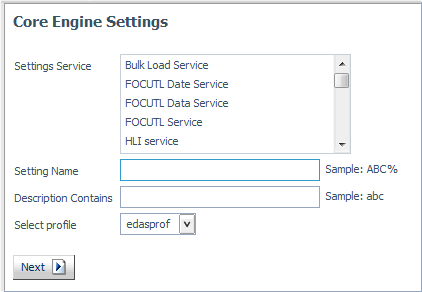
-
Select a service from the Settings Service list.
-
Optionally, enter a string in the Setting
Name field to find specific settings, using % as a wildcard.
For example, to find settings containing DATE, enter DATE%.
All settings are upper case and the Setting Name field
is case sensitive.
-
Optionally, enter a string in the Description Contains field
to search for settings by their descriptions.
-
Optionally, select a profile from the Select profile drop-down
menu.
-
Click Next.
The Change Core Engine Settings pane opens, as shown in
the following image.
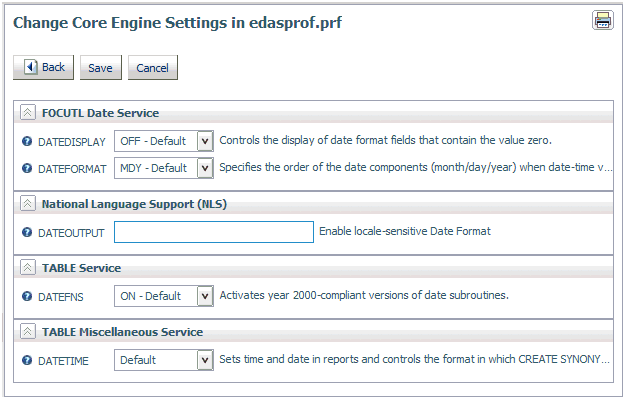
-
Make your changes and click Save.
The
following confirmation message displays:
Core engine settings successfully changed in edasprof.prf
x
Core System variables control the functionality of the
server.
The variables fall into the following categories:
- Display Information
- Operating System
- Release Information
- National Language Support
- File Information
- Statistical Variables
- Date/Time Variables
- Security Information
- Miscellaneous System Variables
x
Procedure: How to View Core System Variables
To
view Core System variables:
-
Select Workspace from the
menu bar.
-
From the ribbon, click the Settings icon,
and select Core System Variables, or right-click
the Workspace folder in the navigation pane,
and select Settings, and then Core
System Variables.
The Core System Variable pane opens, as shown in the following image.
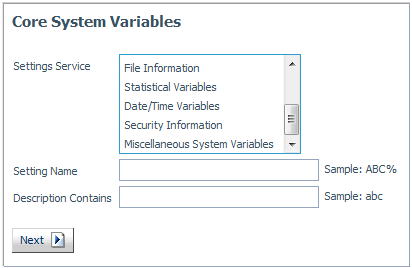
-
Select a service from the Settings Service list.
-
Optionally, enter a string in the Setting
Name field to find specific variables, using % as a
wildcard. Variables are all upper case and all begin with an ampersand
(&).
-
Optionally, enter a string in the Description Contains field
to search for variables by their descriptions.
-
Click Next.
The Core System Variables are displayed, as shown in the
following image.

xCore Engine Global Variables
You can add global variables to a profile on the server
to deliver default values or execute SET commands.
x
Procedure: How to Create Core Engine Global Variables
To
create Core Engine global variables:
-
Select Workspace from the
menu bar.
-
From the ribbon, click the Settings icon,
and select Core Global Variables, or right-click
the Workspace folder in the navigation pane,
and select Settings, and then Core
Global Variables.
The Core Global Variable pane opens, as shown in the following
image.

-
Optionally, select a profile from the drop-down menu.
The default is edaprof.
-
Click Add New.
-
On the Core Global Variable pane, select SET or DEFAULT from
the Command drop-down menu.
-
Enter a name and value for the variable in the corresponding
fields and click Add New, as shown in the
following image.
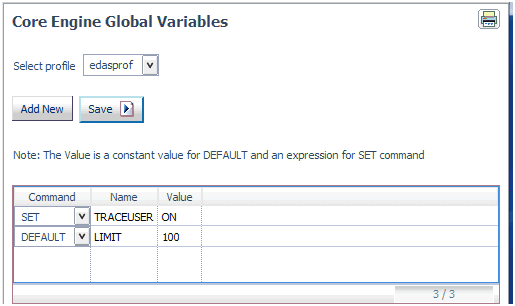
-
Click Save.
x
When you want to be able to reuse data within the same
browser session, you can store the data in the form of a HOLD, SAVE,
or SAVB file in the foccache directory, which is automatically created
when the connection to the server is established. This becomes the
first directory in the application path.
As long as the browser session remains active, the stored files
remain in the foccache directory and can be referenced in requests
using standard two part names. For example, the first request below
creates a HOLD file in foccache, which is referenced by the second request:
TABLE FILE CAR
PRINT CAR
ON TABLE HOLD AS FOCCACHE/myfile
END
TABLE FILE FOCCACHE/myfile
PRINT *
END
When the maximum foccache retention time is reached (180 minutes
by default), the foccache directory is removed by the server and
can no longer be referenced. (For related information, see Application Settings.)
This feature provides an important mechanism for caching and
running multiple instances of WebFOCUS active and drill-down reports.
You can use any WebFOCUS graphical tool to create the request and
generate a report.
Note: Each time a WebFOCUS user logs into the Managed
Reporting (MR) environment, a new session with its own foccache
directory is created. Files that were stored in a prior foccache
directory are no longer accessible. When the user logs out of MR the
foccache directory used within that MR session is no longer accessible.
x
Reference: Application Settings
To
access these settings, select Workspace from
the menu bar. From the ribbon, click the Settings icon,
and select Application Settings, or right-click
the Workspace folder in the navigation pane,
and select Settings, and then Application
Settings.
The Application Settings pane opens,
as shown in the following image.
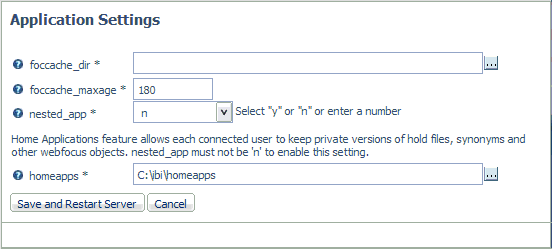
The following Application Settings are
saved in the edaserve.cfg file.
- foccache_dir
-
Defines the location of the foccache directory. The default
is edatemp/foccache/....
- foccache_maxage
-
Defines the maximum number of minutes that a foccache directory
will last. The default is 180 minutes. When the foccache directory
expires, the session also expires.
0
means unlimited (that is, the directory will be remain active as
long as the session lasts or the server is running).
- nested_app
-
For applications containing subfolders or multiple-level
subfolder trees, this parameter controls whether subfolders will
be automatically added to the application path.
The valid
values are:
- A positive integer - Enable nested application,
and only a specific number of subfolder levels in the active application
path.
-
n - Disables nested applications. Only
applications explicitly in the APP PATH will be used.
-
y - Enables nested applications. The
entire application subfolder tree under each application in the
APP PATH is included into active application path.
The
default value is 5.
Note: For z/OS servers, this setting
is only applicable to directory-style applications, it is not applicable
to PDS-style applications nor to applications mapped as a collection
of ddnames.
- homeapps
-
If nested_app is set to y or a number,
homeapps defines the location of the home application root directory.
With homeapps defined, each connected user will see a My
Home applications folder on the Application tree. Users
can create new applications (home applications) in this folder.
These applications will be visible and available only to the connected
user and the server administrator. The user will have full access
to his home applications.
Note: Only available
with a DataMigrator or Managed Reporting license. A WebFOCUS Reporting
Server requires a homeapps license to enable home applications.
When you have completed your entries,
click Save and Restart Server.
x
Miscellaneous Settings allow you to set additional Workspace
operating parameters, including automatic recovery, transaction
coordination, soft and hard kill delays, maximum session log rows,
time window for running response time averages, and proxy server
settings.
x
Reference: Miscellaneous Settings
To
access these settings, select Workspace from
the menu bar. From the ribbon, click the Settings icon,
and select Miscellaneous Settings, or right-click
the Workspace folder in the navigation pane,
and select Settings, and then Miscellaneous
Settings.
The Miscellaneous Settings pane opens,
as shown in the following image.
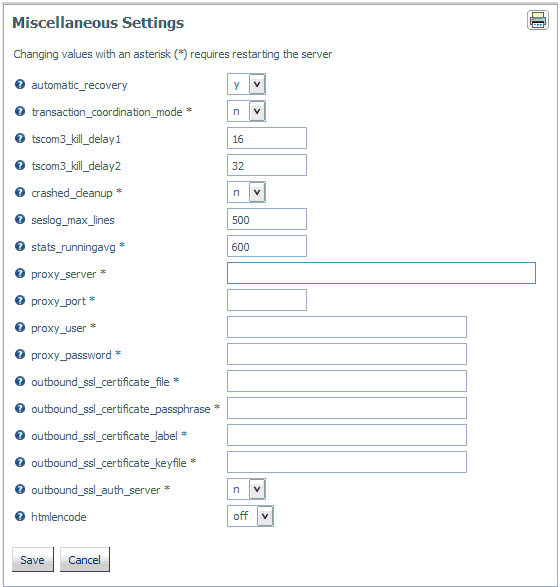
The following Miscellaneous Settings
are saved in the edaserv.cfg file:
- automatic_recovery
-
Determines whether the server will automatically recover
crashed listeners and/or special services. The default is n.
- transaction_coordination_mode
-
Selecting y, activates the iWay Transaction Coordinator.
A Two-Phase Commit will be used when XA-Compliant databases participate
in a transaction. The default is n.
- tscom3_kill_delay1
-
Defines the time (in seconds) allowed for an agent to stop
before soft kill is sent. The default is 16.
- tscom3_kill_delay2
-
Defines the time (in seconds) allowed for a soft kill to
work before a hard kill is sent. The default is 32.
- crashed_cleanup
-
By default, crashed agents are kept in the agents table for
diagnostics purposes, and are only removed when they are explicitly
killed. When this set to y, crashed agents
are automatically removed from agents list when the Workspace Manager
detects a crash. The default value is n.
- crashed_max_dump
-
If crashed_cleanup is set to y, this
determines the number of memory dump files retained for later diagnosis.
- seslog_max_lines
-
Defines the upper limit for the number of rows in a session
log. When the limit is exceeded, only the latest records will be
kept in the session log and the number of records will equal the
limit. The default is 500.
- stats_runningavg
-
Defines the time window for the calculation of running response
time averages. The default is 600.
- proxy_server
-
Defines a proxy server, which acts as an intermediary on
requests for resources from other servers.
- proxy_port
-
Defines the port number of the proxy server.
- proxy_user
-
Defines a user ID for the proxy server.
- proxy_password
-
Defines a password for the user ID connecting to the proxy
server.
- outbound_ssl_certificate_file
-
Required for SSL when using self-signed certificates on i5 systems.
- outbound_ssl_certificate_passphrase
-
Required for SSL when using self-signed certificates on i5 systems.
- outbound_ssl_certificate_label
-
Required for SSL when using self-signed certificates on i5 systems.
- outbound_ssl_certificate_keyfile
-
Required for SSL when using self-signed certificates on i5 systems.
- outbound_ssl_auth_server
-
Required for SSL when using self-signed certificates on i5 systems.
- htmlencode
-
Specifies whether to encode HTML tags in data as plain text
in order to prevent attacks by inserting executable code into data.
z/OS Specific Parameters
- tmpalloc_primary
- tmpalloc_secondary
-
Allocation (in CYLs) for temporary Web Console files allocated
by the HTTP listener. The default is 5 and 50, respectively.
- submit_opt
-
Customizes the call of the IKJEFF10 exit when submitting
jobs with the DYNAM SUBMIT command.
- smf_recno
-
Defines the SMF record number that the server will use to
record utilization statistics.
- smf_subtype
-
Defines which pairs of SMF subtype records are cut. The options
are:
-
all. Cut all
records. This is the default.
-
logon. Cut
logon/logoff subtype only.
-
query. Cut
query begin/query end subtype only.
- privatedd
-
Defines how server will handle allocations for duplicated
ddnames (same ddname allocated both to IRUNJCL and from a customer
application using DYNAM) and what the search strategy will be.
When you have completed your entries,
click Save.
x
Procedure: How to Customize the IKJEFF10 Exit for DYNAM SUBMIT From the Web Console (z/OS)
To
change how the server calls the IKJEFF10 exit, set the submit_opt
parameter as follows:
-
From the
menu bar, select Workspace.
-
From the
ribbon, click the Settings icon, and select Miscellaneous
Settings, or right-click the Workspace folder
in the navigation pane, and select Settings,
and then Miscellaneous Settings.
The Miscellaneous Settings page opens.
-
For the
submit_opt option, assign a separate value (0 or 1) in each of the
three drop-down lists. The default is 000.
The first drop-down list enables the call to IKJEFF10 from
DYNAM SUBMIT. By default, the call is disabled.
-
0
-
Does not call IKJEFF10. This is the default setting.
- 1
-
Calls IKJEFF10.
The second drop-down
list specifies that SUBMIT is to call IKJEFF10 in problem state,
not in supervisor state. The IBM specification for IKJEFF10 requires
supervisor state. If the version of IKJEFF10 in use at your site
is capable of running in problem state, this option may be changed,
thus allowing DYNAM SUBMIT to be used with IKJEFF10 when the server
is not running APF-authorized. When you set:
-
0
-
Supervisor state is required for calling IKJEFF10. This is
the default setting.
- 1
-
Supervisor state is not required to
call IKJEFF10.
The third drop-down list allows SUBMIT to continue
in the event that an error occurs while processing an in-stream
data set. In-stream data sets are created by the following statements
in the job:
//ddname DD *
//ddname DD DATA
/*XMIT
//name XMIT
/*DATASET
If an error is found in
one of the previous statements (for example, a syntax error in the
DLM parameter), the SUBMIT operation is normally cancelled. This
option allows submission of the job to continue, although in such
a case the results are unpredictable since the JCL contained within
the in-stream data set may be erroneously interpreted as part of
the job being submitted.
- 0
Terminates SUBMIT on in-stream data set error. This is the
default setting.
- 1
Does not terminate SUBMIT on in-stream data set error.
-
Click Save.
Your
entries are registered in the edaserve.cfg file.
x
x
x
You can view and change the current license code and provide
and/or change your site code using the License Management page.
The license code is encoded to determine the configuration, additional
products available in the configuration, the number of CPUs on the
server, and the number of user seats the configuration supports.
For more information on how to obtain a new license code, contact
Customer Support or your local Information Builders sales office.
x
Reference: License Settings
To
access these settings, select Workspace from
the menu bar. From the ribbon, click the License icon,
or right-click the Workspace folder in the
navigation pane, and select License.
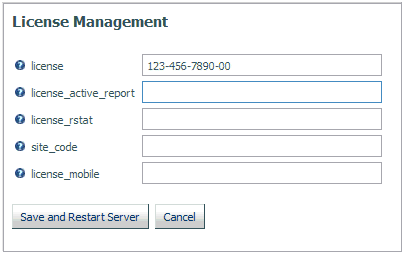
The
following License Management settings are saved in the edaserv.cfg file:
When you have completed
your entries, click Save and Restart Server.
- license
-
Enter the license number (required for the type of server
you are using).
- license_active_report
-
Enter the license number for WebFOCUS Active Technologies.
- license_rstat
-
Enter the license number for the RStat scoring feature.
- site_code
-
Enter the site code number (required for support calls).
- license_mobile
-
Enter the license number for the Mobile Favs feature.
x
x
The Migrate Settings page allows you to migrate a server from
a previous release.
It is recommended that you migrate configuration information
from previous releases after you verify the proper basic installation
of the new release.
x
Procedure: How to Migrate Configuration Information
To
migrate from a previous release:
-
From the
menu bar, select Workspace.
-
From the
ribbon, click the Migrate icon, or right-click
the Workspace folder in the navigation pane,
and select Migrate.
The Migrate page opens.
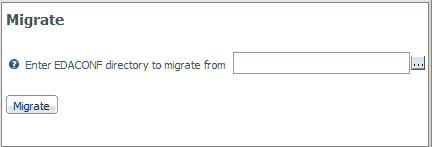
-
Type the
full path of the configuration instance directory (EDACONF) or click
the ellipsis (...) and navigate to it.
-
Click Continue.

























